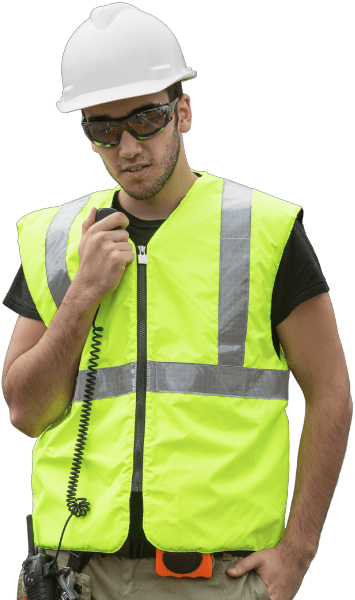Here's a list of useful two way radio terminologies, as well as radio lingo that helps improve the effectiveness of your team’s communication.
Ctrl + F, then type the word you're looking for (Windows) to quickly bring the term you're seeking in view. For Mac, use Cmd + F. However, this list is also in alphabetic order for your ease of reading.
AFRRCS (Alberta First Responder Radio Communication System)
A dedicated two-way radio system for public safety agencies in Alberta, Canada, to ensure interoperability between paramedics, firefighters, police, and public works.
Ambient Noise
Background noise that can interfere with radio communication, especially in industrial settings.
Analog
Two-way radios that transmit voice and data through electrical signals.
Antenna
A component that converts radio signals into electrical currents for audio output.
Base Station
A stationary radio unit that serves as a communication hub, often operated by dispatchers.
Bi-Directional Amplifier (BDA)
A signal booster used to improve in-building radio communication.
Channel
A designated frequency for radio communication.
Channel Selector
A component that allows users to switch between programmed channels.
Coverage Area
The geographic area served by a two-way radio system.
Digital
Radios that transmit information through numeric codes.
DMR (Digital Mobile Radio)
A standard for digital voice communication.
FDMA (Frequency Division Multiple Access)
A method of separating frequencies into channels for radio communication.
Frequency Band
A specific portion of the radio frequency spectrum used for communication.
Gain Control
A function that adjusts the amplitude of transmitted and received signals.
Ingress Protection
A rating indicating a radio's protection against dust and water.
Intrinsically Safe
Radios designed for safe use in hazardous environments with combustible materials.
ISED (Innovation, Science, and Economic Development Canada)
The federal agency managing Radio Frequency (RF) spectrum access and licensing.
Land Mobile Radio (LMR)
Land-based radio communication systems for various agencies.
Lone Worker
A safety feature that alerts when an isolated worker fails to report their status.
Radio Lingo
Affirmative
Normally used when a question is asked, and the reply is YES.
Break, Break
Interruption to a transmission to communicate urgently.
Come in
Asking another party to acknowledge they can hear you.
Emergency Emergency
Distress call – used when there is grave or imminent danger to life – immediate assistance is required
Your organization may also use code words like Code Blue to indicate a non-crucial incident, Code Yellow for an incident requiring immediate response but is not yet dangerous, and Code Red for a serious incident.
If you work in the security sector, then you may employ terms like Cyclone to indicate a violent situation. If you operate in the marine or aviation industries, then you may use specific terms like May-Day to indicate urgent help is needed.
Go Ahead
I am ready for your message.
I Spell
The next word will be spelt out using the phonetic alphabet.
Negative
Normally used when a question is asked and the reply is NO.
Over
Your message is finished – invitation for others to respond/transmit.
Over and Out, or Out
All conversation is finished – no answer is required or expected.
Radio Check
What’s my signal strength? Can you hear me?
Read You Loud and Clear
Your transmission signal is good.
Roger so far
Confirm parts of long message before continuing with rest of message.
Roger That
Message received and understood – similar to Ten Four or Copy That.
Say Again
Repeat all your last transmission.
Say All After/Before
Repeat all after/before a certain key word or phrase.
Stand By
Wait for a short period and I will get back to you.
Wait Out
The waiting period is longer than expected – I will call you as soon as possible.
Wilco
I will comply.
Whatever sector you work in, make sure everyone is familiar with the call signs used in your workplace. Because when everyone uses the same radio communications etiquette, it helps to ensure every message is heard loud and clear.
(Culled from Hytera - in Partnership with Expert Mobile Communications).
Man Down
A safety feature that alerts when a radio is at an unusual angle for an extended period.
Mobile Radio
Two-way radios designed for use in vehicles.
Multimode/Mixed Mode
Radios that can operate in various modes, including analog and digital.
Noise Cancellation
Filtering out background noise to improve voice communication and hearing protection.
P25 (Project 25)
A digital radio standard for public safety communications.
Portable Radio
Handheld two-way radios.
Push-to-Talk (PTT)
The button used for transmitting instant voice messages on a two-way radio.
Push-to-Talk over Cellular (PoC)
A type of two way radio that connects using cellular networks or WIFI. Expert Mobile also offers a way to bridge traditional two way radios with PoC radios on the same network.
Radio Stun
A feature to remotely disable lost or stolen radios for privacy.
Range
The distance a two-way radio can transmit and receive signals.
Repeater
A signal booster for large facilities and outdoor sites. Repeaters extend two way radio coverage area.
RF (Radio Frequency)
The electromagnetic signal used for radio communication.
Scanning
A feature allowing radios to monitor and listen to pre-selected channels.
Speaker Mic (Remote Speaker Mic)
An accessory for transmitting and receiving messages via a microphone.
Squelch
A control that mutes audio when the signal strength drops below a certain level.
Talk Around
A feature allowing radios to communicate directly without using a repeater.
Talk Group
A group of radios that hear the same message, used for communication organization.
TDMA (Time Division Multiple Access)
Dividing a radio channel into time slots for more efficient use.
Trunking
A method for efficiently sharing resources among a large number of radios.
UHF (Ultra-High Frequency)
A radio band suitable for indoor communication.
VHF (Very High Frequency)
A radio band suitable for outdoor environments with longer-range capabilities.
